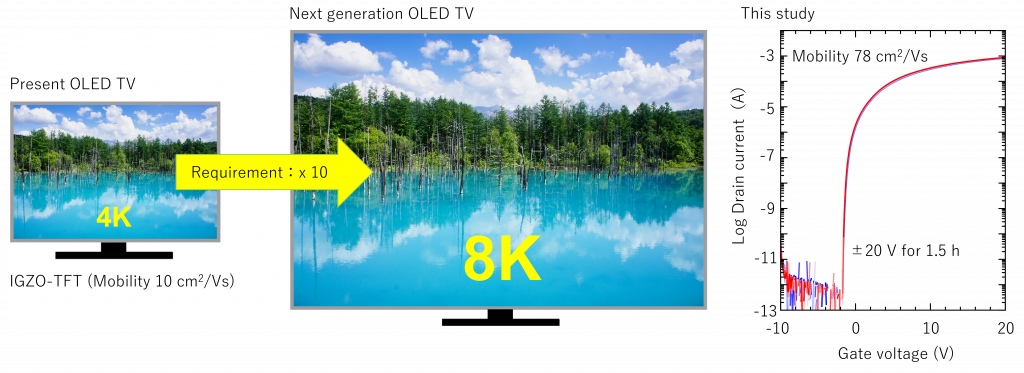Practical Indium Oxide-based Thin-Film Transistors
Prashant R. Ghediya, Yusaku Magari*, Hikaru Sadahira, Takashi Endo, Mamoru Furuta, Yuqiao Zhang, Yasutaka Matsuo, and Hiromichi Ohta*, “Reliable operation in high-mobility indium oxide thin film transistors”, Small Methods 2400578 (2024). (August 3, 2024) (DOI: 10.1002/smtd.202400578)
 Transparent oxide semiconductors (TOSs) based thin-film transistors (TFTs) that exhibit higher field effect mobility (µFE) are highly required toward the realization of next-generation displays. Among numerous types of TOS-TFTs, In2O3-based TFTs are the front-running candidate because they exhibit the highest µFE ≈100 cm2 V−1 s−1. However, the device operation of In2O3 TFTs is unreliable; a large voltage shift occurs especially when negative gate bias is applied due to adsorption/desorption of gas molecules. Although passivation of the TFTs is used to overcome such instability, previously proposed passivation materials do not improve the reliability. Here, it is shown that the In2O3 TFTs passivated with Y2O3 and Er2O3 films are highly reliable and do not show threshold voltage shifts when applying gate bias. Positive and negative gate bias is applied to the In2O3 TFTs passivated with various insulating oxides and found that only the In2O3 TFTs passivated with Y2O3 and Er2O3 films do not exhibit threshold voltage shifts. It is observed that only the Y2O3 grew heteroepitaxially on the In2O3 crystal. This is the origin of the high reliability of the In2O3 TFTs passivated with Y2O3 and Er2O3 films. This finding accelerates the development of next-generation displays using high-mobility In2O3 TFTs.
Transparent oxide semiconductors (TOSs) based thin-film transistors (TFTs) that exhibit higher field effect mobility (µFE) are highly required toward the realization of next-generation displays. Among numerous types of TOS-TFTs, In2O3-based TFTs are the front-running candidate because they exhibit the highest µFE ≈100 cm2 V−1 s−1. However, the device operation of In2O3 TFTs is unreliable; a large voltage shift occurs especially when negative gate bias is applied due to adsorption/desorption of gas molecules. Although passivation of the TFTs is used to overcome such instability, previously proposed passivation materials do not improve the reliability. Here, it is shown that the In2O3 TFTs passivated with Y2O3 and Er2O3 films are highly reliable and do not show threshold voltage shifts when applying gate bias. Positive and negative gate bias is applied to the In2O3 TFTs passivated with various insulating oxides and found that only the In2O3 TFTs passivated with Y2O3 and Er2O3 films do not exhibit threshold voltage shifts. It is observed that only the Y2O3 grew heteroepitaxially on the In2O3 crystal. This is the origin of the high reliability of the In2O3 TFTs passivated with Y2O3 and Er2O3 films. This finding accelerates the development of next-generation displays using high-mobility In2O3 TFTs.
Paper P. R. Ghediya, Y. Magari* et al., Small Methods 2400578 (2024) (DOI: 10.1002/smtd.202400578)

